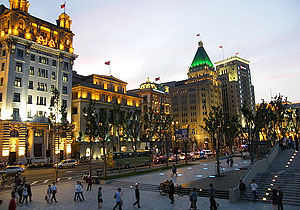The Bund

Global society has individualized the Bund in Shanghai with various titles like "the World Expo of Architectures", "Wall Street in the east", etc. Located by the Huangpu River, its rapid economic development owes to a complicated history. In the 1840s, the Bund was taken as the English and French Concessions. As the city of Shanghai was opened to foreign trade, numerous foreign business ships docked in the Huangpu River; and politicians and businessmen from the western countries disembarked at and occupied the Bund during the 100 years before the 1940s.
The dwellings along the Bund, shops, banks and consulates, showcase a scroll painting of Shanghai history. As one of its nicknames – "the World Expo of Architectures" indicates, the Bund houses 52 buildings of various architectural styles such as Romanesque, Gothic, Renaissance, Baroque, Neo-Classical, Beaux-Arts, and Art Deco. All the buildings present diverse exotic cultures assimilated into this city; and now most of them continue to be used as the headquarters of banks. Due to the flourishing trade and business here, the Bund is regarded by entrepreneurs from time to time, as a "treasure land", symbolizing wealth, fame and fortune.
On the Bund there are some worth-seeing spots for you to enjoy. Huangpu Park on the Bund, a witness of Shanghai's vicissitudes, is the earliest European-style park in Shanghai. The Garden Bridge of Shanghai, an all-steel constructed bridge, is located in the west of the Park, and serves as one of the landmarks in Shanghai, an important passageway connecting the city center with Shanghai north and east. You can also take the sightseeing tunnel from the Bund to the Oriental Pearl Tower across the Huangpu River to have an exciting experience.